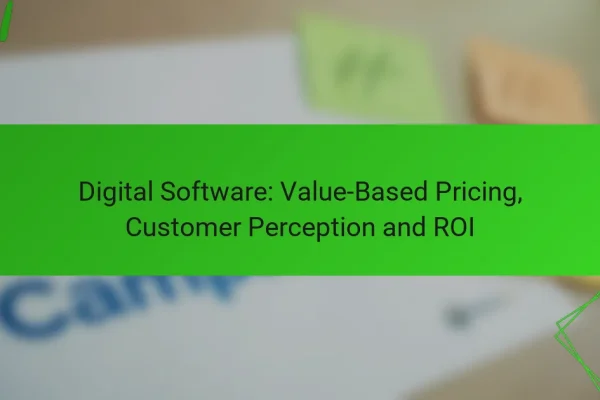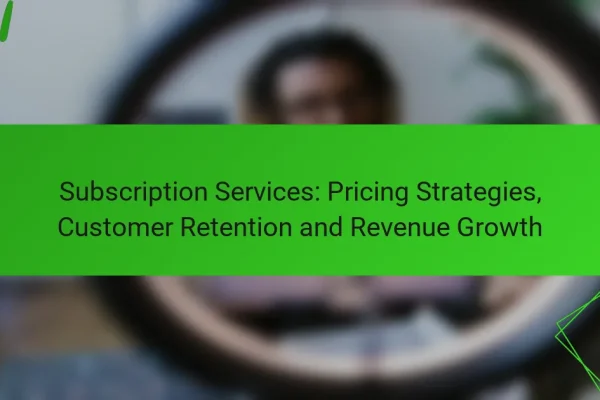What are effective pricing strategies for digital products in Australia?
Effective pricing strategies for digital products in Australia include value-based pricing, freemium models, tiered pricing, dynamic pricing, and subscription pricing. Each strategy has its own advantages and considerations that can help businesses optimize revenue and meet customer expectations.
Value-based pricing
Value-based pricing sets prices based on the perceived value to the customer rather than the cost of production. This approach requires understanding customer needs and how much they are willing to pay for specific features or benefits.
For instance, a software tool that significantly improves productivity can command a higher price if users recognize its value. Businesses should conduct market research and gather customer feedback to effectively implement this strategy.
Freemium model
The freemium model offers basic features for free while charging for premium features. This strategy attracts a large user base quickly, allowing customers to experience the product before committing financially.
Many apps and online services, such as cloud storage providers, utilize this model. It’s crucial to ensure that the free version provides enough value to entice users while making the premium features compelling enough to convert them into paying customers.
Tiered pricing
Tiered pricing involves offering multiple pricing levels, each with different features or services. This allows customers to choose a plan that best fits their needs and budget, increasing the likelihood of conversion.
For example, a digital marketing tool might offer a basic plan for small businesses, a mid-tier plan for growing companies, and an enterprise plan for larger organizations. This strategy can maximize revenue by catering to various customer segments.
Dynamic pricing
Dynamic pricing adjusts prices based on demand, competition, or other market factors. This strategy can help maximize profits during peak times while remaining competitive during slower periods.
For example, an online course platform might increase prices during high-demand seasons or offer discounts during off-peak times. Businesses should use data analytics to monitor market trends and customer behavior to effectively implement dynamic pricing.
Subscription pricing
Subscription pricing charges customers a recurring fee for continuous access to a product or service. This model provides predictable revenue and fosters customer loyalty over time.
Many software companies and streaming services use subscription pricing, offering monthly or annual plans. It’s essential to provide ongoing value to retain subscribers, such as regular updates, new features, or exclusive content.
How to determine the right price for digital products?
Determining the right price for digital products involves assessing market demand, competitor pricing, and customer perceptions. A well-researched price point can enhance sales and customer satisfaction while ensuring profitability.
Market research
Conducting market research is crucial to understanding the demand for your digital product. Identify your target audience, their needs, and their willingness to pay. Surveys, focus groups, and online tools can help gather insights into customer preferences and price sensitivity.
Additionally, analyze trends in your industry to gauge how similar products are priced. This can provide a benchmark for setting your own prices, ensuring they align with market expectations.
Competitor analysis
Competitor analysis involves examining how similar digital products are priced in the market. Look at both direct competitors and those offering alternative solutions. This comparison can reveal pricing strategies that work well and those that do not.
Consider factors such as features, quality, and customer service when evaluating competitors. If your product offers unique benefits, you may justify a higher price. Conversely, if you’re entering a saturated market, competitive pricing may be necessary to attract customers.
Customer feedback
Customer feedback is invaluable for refining your pricing strategy. Engage with your audience through reviews, social media, and direct communication to understand their perceptions of value. This can highlight whether your pricing aligns with customer expectations.
Implementing A/B testing can also help determine the most effective price point. By offering different prices to segments of your audience, you can analyze which price yields the best sales results while maintaining customer satisfaction.
What are common pricing mistakes to avoid?
Avoiding common pricing mistakes is crucial for the success of digital products. Missteps can lead to lost revenue, diminished brand value, and customer dissatisfaction.
Underpricing
Underpricing occurs when a product is set at a price lower than its perceived value or market standards. This can lead to a perception of low quality and may attract customers who are not loyal, ultimately harming long-term profitability.
To avoid underpricing, research competitors and understand the value your product offers. Consider using tiered pricing to capture different customer segments while still reflecting the product’s worth.
Ignoring costs
Ignoring costs means failing to account for all expenses associated with creating and delivering a digital product. This oversight can result in pricing that does not cover costs, leading to financial losses.
To prevent this mistake, calculate all direct and indirect costs, including development, marketing, and support. Ensure that your pricing strategy includes a margin that supports business sustainability.
Not testing prices
Not testing prices can limit your understanding of how price changes affect sales and customer behavior. Without testing, you may miss opportunities to optimize revenue.
Implement A/B testing to evaluate different price points and gather data on customer responses. Regularly review and adjust pricing based on market trends and customer feedback to maximize sales potential.
How to implement psychological pricing techniques?
Psychological pricing techniques leverage consumer behavior to influence purchasing decisions. By understanding how customers perceive prices, businesses can strategically set their pricing to enhance sales and profitability.
Charm pricing
Charm pricing involves setting prices just below a round number, such as $9.99 instead of $10. This technique creates the perception of a better deal, as consumers tend to focus on the leftmost digits. It is widely used in retail and digital products alike.
When implementing charm pricing, consider testing various price points to see which resonates best with your audience. For example, a digital subscription priced at $4.99 may attract more customers than one priced at $5.00.
Price anchoring
Price anchoring is the practice of presenting a higher-priced item alongside a lower-priced option to make the latter seem more appealing. This strategy helps customers evaluate value based on the initial price they see. For instance, if a premium digital product is priced at $199, a standard version at $99 will appear more reasonable.
To effectively use price anchoring, ensure that the higher-priced option offers clear additional benefits. This can justify the price difference and help customers feel they are making a smart choice by opting for the lower-priced item.
Bundle pricing
Bundle pricing involves offering multiple products or services together at a lower rate than if purchased separately. This strategy can increase perceived value and encourage customers to buy more. For example, a software suite that includes several applications for $49 may be more attractive than purchasing each application individually for $15 each.
When creating bundles, ensure that the combined products are complementary and provide a cohesive experience. Avoid overloading customers with too many options, as this can lead to decision fatigue and reduce overall sales.
What metrics should be tracked for pricing effectiveness?
To assess pricing effectiveness, focus on key metrics such as conversion rates, customer acquisition cost, and customer lifetime value. These metrics provide insights into how well your pricing strategy is performing and where adjustments may be necessary.
Conversion rates
Conversion rates measure the percentage of visitors who complete a desired action, such as making a purchase. Tracking this metric helps determine how effectively your pricing attracts customers. A higher conversion rate often indicates that your pricing aligns well with customer expectations and perceived value.
To improve conversion rates, consider A/B testing different pricing models or promotional offers. For example, you might experiment with a limited-time discount or a tiered pricing structure to see which approach yields better results.
Customer acquisition cost
Customer acquisition cost (CAC) refers to the total expense incurred to acquire a new customer, including marketing and sales costs. Understanding CAC is crucial for evaluating the sustainability of your pricing strategy. If CAC is too high relative to the revenue generated from customers, adjustments may be necessary.
To optimize CAC, analyze your marketing channels and focus on those that yield the best return on investment. For instance, if social media advertising is driving high-quality leads at a lower cost, consider reallocating your budget to enhance that channel.
Customer lifetime value
Customer lifetime value (CLV) estimates the total revenue a business can expect from a single customer over their entire relationship. This metric is vital for understanding how pricing impacts long-term profitability. A higher CLV suggests that your pricing strategy is effective in retaining customers and encouraging repeat purchases.
To increase CLV, consider implementing loyalty programs or subscription models that incentivize ongoing engagement. For example, offering discounts for repeat purchases can enhance customer retention and boost overall lifetime value.











